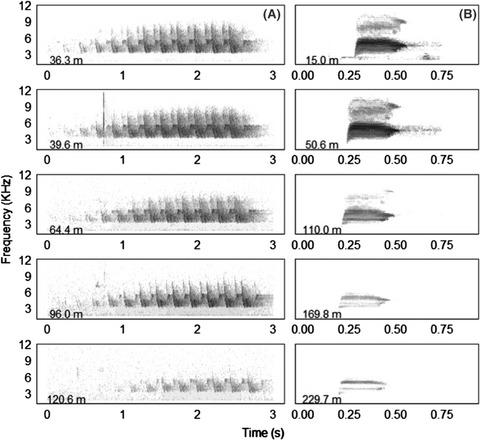当前位置:
X-MOL 学术
›
Remote Sens. Ecol. Conserv.
›
论文详情
Our official English website, www.x-mol.net, welcomes your
feedback! (Note: you will need to create a separate account there.)
Sound level measurements from audio recordings provide objective distance estimates for distance sampling wildlife populations
Remote Sensing in Ecology and Conservation ( IF 3.9 ) Pub Date : 2019-04-29 , DOI: 10.1002/rse2.118 Daniel A. Yip 1 , Elly C. Knight 1 , Elène Haave‐Audet 1 , Scott J. Wilson 1 , Connor Charchuk 1 , Chris D. Scott 2 , Péter Sólymos 1, 3 , Erin M. Bayne 1
Remote Sensing in Ecology and Conservation ( IF 3.9 ) Pub Date : 2019-04-29 , DOI: 10.1002/rse2.118 Daniel A. Yip 1 , Elly C. Knight 1 , Elène Haave‐Audet 1 , Scott J. Wilson 1 , Connor Charchuk 1 , Chris D. Scott 2 , Péter Sólymos 1, 3 , Erin M. Bayne 1
Affiliation

|
Distance sampling is widely used to estimate animal population densities by accounting for imperfect detection of individuals with increasing distance from an observer. Distance sampling assumes that distances are measured without error; however, it is often applied to human estimated distances, which are known to be inconsistent, inaccurate, and biased. We present an objective technique for estimating distance to vocalizing individuals that relies on the relative sound level (RSL) of the vocalization extracted from autonomous recording unit (ARU) recordings and show the error is less than human estimated error extracted from a literature case study. RSL predicted distances can be obtained by manual measurement in sound viewing software, or automatically with automated signal recognition software. We built calibration datasets of Ovenbirds (Seiurus aurocapilla) and Common Nighthawks (Chordeiles minor) recorded at known distances and used regression of RSL from those recordings to predict distance. There was no error bias of RSL predicted distances when compared to known distances for Common Nighthawk, minimal error bias for Ovenbird, and error from all RSL predicted distances was less than human estimated error extracted from the literature. We then simulated ARU point count surveys with a known density and estimated that density with distance sampling to test whether RSL distance prediction does not violate the assumption that distances are measured without error. There was no difference in density estimates from known distance and density estimates obtained from RSL predicted distance, while density estimates contaminated with human estimated error were significantly lower than density estimates from known distance. We found that a calibration dataset of approximately 300 vocalizations was suitable to minimize error for both species, and so conclude that RSL distance prediction is an accessible method of improving distance estimates relative to human estimation. We provide general recommendations on how to collect calibration recordings for the application of RSL distance prediction to other species and areas.
中文翻译:

录音中的声级测量可为野生动物种群的距离采样提供客观的距离估计
通过考虑与观察者之间距离的增加,对个体的不完善检测,距离采样被广泛用于估计动物种群密度。距离采样假定距离的测量没有错误;但是,它通常应用于人类估计的距离,这是不一致,不准确和有偏差的。我们提出了一种客观的估计发声距离的技术,该技术依赖于从自主记录单元(ARU)录音中提取的发声的相对声级(RSL),并且显示出的误差小于从文献案例研究中提取的人类估计的误差。RSL预测距离可以通过在声音查看软件中进行手动测量来获得,也可以通过自动信号识别软件来自动获得。我们建立了Ovenbirds(Seiurus aurocapilla)和常见的夜鹰(Chordeiles小)以已知距离进行记录,并使用RSL从这些记录中回归来预测距离。与Common Nighthawk的已知距离相比,RSL预测距离没有误差偏倚,Ovenbird的误差误差很小,并且所有RSL预测距离的误差都小于从文献中提取的人类估计误差。然后,我们以已知密度模拟ARU点计数调查,并通过距离采样估算密度,以测试RSL距离预测是否不违反测距无误的假设。从已知距离得出的密度估计值与从RSL预测距离得出的密度估计值没有差异,而被人为估计误差污染的密度估计值则明显低于来自已知距离的密度估计值。我们发现,大约300个发声的校准数据集适合最小化两个物种的误差,因此得出结论,RSL距离预测是一种相对于人类估计而言改进距离估计的可访问方法。我们提供有关如何收集校准记录以将RSL距离预测应用于其他物种和地区的一般建议。
更新日期:2019-04-29
中文翻译:

录音中的声级测量可为野生动物种群的距离采样提供客观的距离估计
通过考虑与观察者之间距离的增加,对个体的不完善检测,距离采样被广泛用于估计动物种群密度。距离采样假定距离的测量没有错误;但是,它通常应用于人类估计的距离,这是不一致,不准确和有偏差的。我们提出了一种客观的估计发声距离的技术,该技术依赖于从自主记录单元(ARU)录音中提取的发声的相对声级(RSL),并且显示出的误差小于从文献案例研究中提取的人类估计的误差。RSL预测距离可以通过在声音查看软件中进行手动测量来获得,也可以通过自动信号识别软件来自动获得。我们建立了Ovenbirds(Seiurus aurocapilla)和常见的夜鹰(Chordeiles小)以已知距离进行记录,并使用RSL从这些记录中回归来预测距离。与Common Nighthawk的已知距离相比,RSL预测距离没有误差偏倚,Ovenbird的误差误差很小,并且所有RSL预测距离的误差都小于从文献中提取的人类估计误差。然后,我们以已知密度模拟ARU点计数调查,并通过距离采样估算密度,以测试RSL距离预测是否不违反测距无误的假设。从已知距离得出的密度估计值与从RSL预测距离得出的密度估计值没有差异,而被人为估计误差污染的密度估计值则明显低于来自已知距离的密度估计值。我们发现,大约300个发声的校准数据集适合最小化两个物种的误差,因此得出结论,RSL距离预测是一种相对于人类估计而言改进距离估计的可访问方法。我们提供有关如何收集校准记录以将RSL距离预测应用于其他物种和地区的一般建议。











































 京公网安备 11010802027423号
京公网安备 11010802027423号